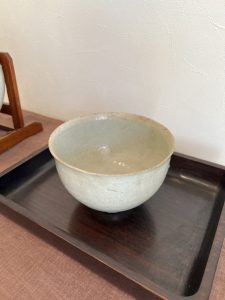李朝白磁の魅力(愛知県名古屋市千種区姫池通 骨董買取 古美術風光舎)
2024.03.21
みなさまこんにちは、スタッフYでございます。
HPやSNS等でお知らせしておりますように古美術風光舎では、来月、4月5,6,7日、ここ覚王山の店舗におきまして『器と骨董展』を開催いたします。6,7日は覚王山祭りも開催しておりますので、お祭りの寄り道にふらりとお立ち寄りくださいませ。
そんな器展の開催にあたって、自分も少し骨董の器のおさらいをしているのですが、本日は李朝の白磁についての調べものをしております。
李朝の白磁の魅力、一緒に探っていきましょう。

李朝白磁は14世紀から19世紀末期まで続いた李氏朝鮮で作られた白磁のことなのですが、その美しさや希少性の高さから非常に人気が高く、高値で取引されることもある骨董品であります。
朝鮮半島では高麗時代には「高麗青磁」と呼ばれるや青磁が作られ、高麗青磁が衰退すると白い釉薬をかけた「粉青沙器」が作られるなど、古くから陶磁器が盛んに作られておりまして、もとは、中国の元、明の白磁の影響を受けたといわれていますが、時代が経つにつれて独自の発展を遂げ、中国の白磁とは異なる道を辿っていくこととなるのですが。
李氏朝鮮時代の初期に作られていたのは主に粉青沙器でしたが、中国から白磁の技術が伝わると、白く輝くような高貴さや高潔さ、白が持つ純潔のイメージが愛され、朝鮮半島でも次第に白磁が作られるようになりました。(どうやら歴史的には青磁が先に出来上がっていたようですね。)
その結果、16世紀前半になると粉青沙器は姿を消し、17世紀に入る頃には完全に白磁に置き換わりっていきます。李朝白磁は初期のころは焼き上げた白土を上塗りして装飾を施すという技法が用いられていましたが、陶工たちが磁器の鉱石を求めて広州市に移り住み、15世紀に道馬里で官窯が築かれると独自に発展し始めます。
その後、清朝の侵攻の影響で道馬里での白磁製造は衰退しますが、その技術は金沙里にひきつがれ、官窯が作られて質の高い白磁が数多くつくられるようになります。
そして、王朝が衰退しはじめた1752年に金沙里から広州に窯が移転され李朝白磁生産の中心になりますが1883年に窯が民営化されて官窯の歴史は終わり、1910年の日韓併合で李氏朝鮮の時代も終わりとなりました。
それにしても、やはり500年もの歴史の間作られていたのですからその特徴は少しずつことなるようでして。
それぞれ初期、中期、後期の分けられるのですが、李朝白磁が始まった14世紀から道馬里で作られていた16世紀の李朝初期、金沙里で作られていた1700年から1750年頃の李朝中期、1752年に広州に窯が移転した後の李朝後期に分けられます。
初期李朝は焼き上がった時に白い土を上塗りして装飾を施した素朴な品と、白地に酸化コバルトの釉で絵付けを施した品があり、どちらも器体の色が白灰色をしているのが特徴であります。
そして、優れた品が多いといわれる李朝中期になると器体の色が灰白色から乳白色に変わりより美しく変化。後期李朝は中期李朝と似ていますが、中期李朝よりもずっしりとした重みがあるのが特徴となっていき、また、初期や中期は青で絵付けが施されていましたが、後期に入ると赤で絵付けした品も登場してきました。
さすがに500年も作られておりますと、時代によって異なる特徴を持つ李朝白磁なのですが、どの時代においても中国の白磁などに比べると底が厚いという特徴があるようです。
また、器肌が滑らかで手触りがよく、「雪のような」と例えられるほど白く美しいことも大きな特徴。李朝白磁の魅力は、この滑らかな肌と高貴な白さ、どっしりとした重厚感と品格、さらに時代によって異なる装飾や形の特徴、その希少性の高さなどが相まって、昨今気になる存在の器になっていたのでしょうか。
その歪み、厚手のどっしり感、素朴さは、これまで中国渡りのシンメトリーで薄手、上品さが好まれた時代からすると、李朝の雑器は宮廷感覚にはなんとも程遠い仕上りでなのですが、それこそが「完全の美」というよりも「不完全の美」といいましょうか、それらが利休以来の侘び、寂を尊ぶ日本人の心を鷲づかみにしたようですね。現在も当時茶道具なども日本の美術館にたくさん展示されており、李朝白磁への憧れが伝わってきます。

では、なぜにこのような素朴な器になったのか。
一説に李朝時代(約500年間)は仏教にかわり朱子学(儒教)の世となり、抑仏崇儒政策で生活様式が質素を好む思想に一変したからだとも推測されます。
15世紀初頭、焼き物も清潔で簡素な器が主流になり、中でも白磁は王家の器とされ一時期一般国民の白磁器使用を禁じた程でありました。この時代は世界的に陶磁器に白磁が絶対なるあこがれの存在のようでして、その大らかさ、素朴さ、暖かさは李王朝特有の産物であります。
ですが毒殺を恐れた王宮では銀の食器を多岐に採用し、利用頻度の減った陶磁器は進歩、発展を王朝から期待されずにそのままの姿で生き延びたのではとも言われております。
よって、長年、実用一辺倒の焼物が過剰な美意識に毒されることも無く、陶工達の素直な感覚と屈託の無い仕上がりがそのまま今日に至っているということのようですね。
それにしても、500年もの間、こうやってあまり変化することもなく生き延びた武骨な李朝白磁を趣深く手にとることができるとは。何が功を奏るかは長い年月を経てやっとわかることもあるのだな…。などと、その重みが教えてくれたような気がいたしました。
それではごきげんよう。
Hello everyone, this is Staff Y.
As we have announced on our website and SNS, we will hold an exhibition of “Vessels and Antiques” at our store in Kakuozan on April 5, 6, and 7, and the Kakuozan Festival will be held on April 6 and 7, so please drop by on your way to the festival.
I have been doing some research on Yi Dynasty white porcelain today.
Let’s explore the charm of Yi Dynasty white porcelain together.
Yi Dynasty white porcelain is white porcelain produced in the Yi Dynasty Korea, which lasted from the 14th century to the end of the 19th century. It is an antique that is very popular and sometimes traded at a high price because of its beauty and rarity.
In the Korean Peninsula, celadon porcelain called “Goryeo celadon” was produced during the Goryeo Dynasty, and when Goryeo celadon declined, white glazed “powdered celadon” was produced, and ceramics have been actively produced since ancient times.
Originally influenced by the white porcelain of the Yuan and Ming Dynasties in China, it developed its own unique style as time went by and followed a different path from Chinese white porcelain.
In the early Yi Dynasty, white porcelain was mainly made of powdered celadon, but when the technique of white porcelain was introduced from China, white porcelain gradually began to be produced on the Korean peninsula, as people loved the image of nobility and purity that the white color, shining white, had. (Apparently, historically, celadon porcelain was produced first.)
) As a result, in the first half of the 16th century, celadon porcelain disappeared, to be completely replaced by white porcelain by the beginning of the 17th century. In the early days, Yi Dynasty white porcelain used the technique of decorating by painting over fired white clay, but it began to develop on its own after potters moved to Gwangju City in search of porcelain ore, and official kilns were built in Doma-ri in the 15th century.
Although white porcelain production in Doumari declined due to the Qing Dynasty’s invasion, the technique was inherited in Jinshali, where official kilns were built and many high-quality white porcelain pieces were produced.
In 1752, when the dynasty began to decline, the kilns were moved from Geumsari to Gwangju, which became the center of Yi Dynasty white porcelain production, but in 1883, the kilns were privatized, ending the history of the official kilns, and the Yi Dynasty came to an end with the annexation of Korea and Japan in 1910.
However, since the kilns had been produced for 500 years, their characteristics seem to have varied little by little.
They can be divided into the early, middle, and late Yi Dynasty periods: the early Yi Dynasty period from the 14th century, when Yi Dynasty white porcelain was first produced in Doma-ri in the 16th century; the middle Yi Dynasty period from 1700 to 1750, when it was produced in Geumsa-ri; and the late Yi Dynasty period after the kilns were relocated to Gwangju in 1752.
Early Yi Dynasty wares were either rustic, decorated with a white overglaze of clay when fired, or painted with a cobalt oxide glaze on a white ground, both characterized by the white-gray color of the vessel body.
In the mid Yi Dynasty, which is said to have many excellent pieces, the color of the vessel changed from grayish white to milky white, and it became more beautiful.
Late Yi Dynasty wares are similar to those of the Middle Yi Dynasty, but they are heavier and heavier than those of the Middle Yi Dynasty.
As might be expected after 500 years of production, Yi Dynasty white porcelain has different characteristics depending on the period, but in all periods, the bottom is thicker than that of Chinese white porcelain.
Another major characteristic of Yi Dynasty white porcelain is that its surface is smooth to the touch and so beautifully white that it has been likened to “snow. The charm of Yi Dynasty white porcelain is the combination of its smooth skin, noble whiteness, solid massiveness and dignity, as well as the characteristics of its decoration and shape, which vary from period to period, and its rarity, which have made it a vessel of interest in recent times.
The distortion, thick solidity, and simplicity of the Yi dynasty’s miscellaneous vessels are far removed from the courtly sense of beauty from the period when symmetry, thinness, and elegance were favored in the Chinese tradition, but this is the beauty of imperfection rather than the beauty of perfection. It seems to have grabbed the hearts of Japanese people who respected wabi and sabi since the days of Rikyu. Even today, there are many tea ceremony utensils from that period on display in Japanese museums, which shows the admiration for Yi Dynasty white porcelain.
So, why did it become so simple?
One theory is that during the Yi Dynasty (about 500 years), Buddhism was replaced by Zhu Zi (Confucianism), and the lifestyle changed drastically in favor of simplicity due to the policy of suppressing Buddhism and worshipping Confucianism.
In the early 15th century, clean and simple pottery became the mainstream, and white porcelain, in particular, was considered royal vessels, so much so that the use of white porcelain by the general public was banned for a time. White porcelain was considered to be royal vessels, and the use of white porcelain was even forbidden to the general public for a period of time.
However, it is said that the royal court, which feared poisoning, adopted silver tableware for a wide range of uses, and ceramics, which were used less frequently, survived in their original form without the expectation of progress and development from the dynasty.
Therefore, it seems that pottery, which has long been focused on practical use, has not been poisoned by an excessive sense of beauty, and the honest sense and carefree workmanship of the potters have continued to the present day.
It is a rare opportunity to hold in one’s hands the rugged Yi Dynasty white porcelain that has survived for 500 years without much change. It seems that sometimes it is only after a long time that we finally learn what works.
Have a good day.
*******************
ご実家の整理やお片付けなどをされている方のご相談などが多くございます。
お片付けなどくれぐれもご無理のないようになさってくださいませ。
風光舎では古美術品や骨董品の他にも絵画や宝石、趣味のお品など様々なジャンルのものを買受しております。
お片付けをされていて、こういうものでもいいのかしらと迷われているものでも、どうぞお気軽にご相談下さいませ。
また風光舎は、出張買取も強化しております。ご近所はもちろん、愛知県内、岐阜県、三重県その他の県へも出張いたします。
まずは、お電話お待ちしております。
愛知県名古屋市千種区姫池通
骨董 買取【古美術 風光舎 名古屋店】
TEL052(734)8444
10:00-18:00 OPEN

